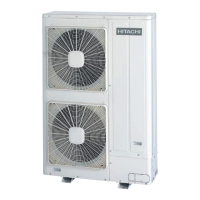b. Heating operation (this is applicable when the outdoor temperature is higher than 0 °C).
No. Check item Standard Causes Result
1
Are oE1 and oE2 (opening of the outdoor unit
expansion valves) abnormally low or high when
TdSH is between 15 and 45 degrees?
—
• Low: excessive refrigerant.
• High: insufficient refrigerant.
2
Is Pd between “1.6” and “3.5”?
(Pd is high when the indoor temperature is high).
—
• Low: solenoid valve SVA leak .
• High: excessive pressure loss
in the gas pipe.
3 Is Ps between "0.2" and "1.1"? —
• Low: outdoor unit short-circuit.
• low/high: outdoor
unit fan motor
failure, fan module failure or
outdoor unit ambient
temperature thermistor failure.
4
Is the difference in temperature between indoor
units* more
than 10 °C when
iE (indoor unit
expansion valve) is "100?
*
The difference in temperature between indoor units
means the following:
b3 (discharge air temperature) -b2 (air inlet
temperature)
indicated on the remote control by the
check mode.
However, this is only applicable when
b2 (Air inlet
temperature)
-
b1 (setting temperature) is higher
than 3 °C.
—
• Failure such as PCB, wiring,
indoor unit
expansion valve and
coil
• Excessive pressure loss in the
pipe.
• Thermistor failure for air
discharge
N O T E
Underlined indicates checking items and the mark " " indicates checking data.
7.2.6 Automatic judgement system for refrigerant amount
< Before refrigerant amount judgement >
(1) Check the indoor and outdoor temperature in the picture.
(2) Calculate the amount of refrigerant for the length of the pipe and add it.
Outdoor Temperature [°C]
Indoor Air Temperature [°C]
Refrigerant Amount Judgement
0 10 20
43
10
32
7 Test run
143
SMGB0065 rev. 1 - 12/2010
7

